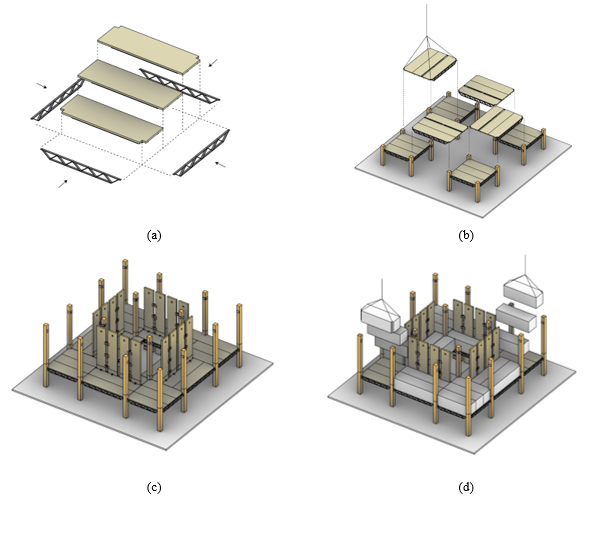1) Advanced tall modular timber buildings: A carbon-neutral, resilient, and smart solution 
The pandemic has changed how we work. As people start to work from home, many will remain to work remotely even after the pandemic is over. This results in increasing housing demand added to the existing housing crisis. Creating wood-based modular structures to overcome the existing housing issue is a new economic opportunity which can be addressed through extensive research and knowledge mobilization. To ensure civil infrastructure is responsive to emerging demands and aid Canada’s objective in reaching on-site net-zero emissions by 2050, this project aims to develop and provide a framework for novel high-performance modular timber high-rise structures, which are carbon-neutral, long-lasting, and resilient.
The project has been divided into several sections to foster sustainable development of urban areas. The expected outcomes from the structural and wood engineering collaborators are to develop and test high-performance and resilient timber tall buildings with a focus on connections to improve the modularity. The research will be accomplished through advanced analytical simulation and experimental testing to validate the feasibility of the proposed modular timber structures. The expected outcomes from the construction team are an integrated robotic construction system capable of on-site assembly and installation of the designed timber modules and connections using the developed AI-based algorithms.

To reach a practical and cost-effective carbon-neutral building solution, research is undertaken at the component, system, and building levels by forming three task groups. Task group 1 focuses on developing an innovative connection solution for cross-laminated timber assemblies. An algorithm will be implemented to optimize the sizes and thickness of the wood-based panels and steel parts, and fastenings, forming this innovative assembly method. Full-scale experimental tests are conducted to assess the actual behavior of the timber components and test their fabrication strategy. Task group 2 concentrates on developing a practical modular balloon-frame cross-laminated timber archetypes with energy dissipation devices. The modules of the proposed prototypes are optimized for different conditions, including loadings, transportation, etc. A state-of-the-art hybrid simulation technique, which combines physical testing and computer modelling is employed to investigate performance of proposed solution.


Task group 3 focuses on developing vision-based algorithms which enable accurate semantic segmentation of on-site building components and personnel. This group also leads development of robotic control algorithms for on-site assembly and installation of the designed timber modules and their connections. These algorithms provide a cost-effective and proactive option for on-site construction control, which will improve the cost-efficiency for modular timber construction as well as alleviate the skilled labour shortage for quality control on-site.

Outputs of project will be of interest to many sectors of the building industry, from Canadian companies working in primary and secondary wood products and processing, to manufacturers of fasteners and mechanical devices, and ultimately to the construction industry. From an application standpoint, the research will set guidelines for the design of tall timber buildings, and release technical information to support practitioners and professionals, builders, and professionals working in civil engineering sectors or industrial processes.

Workflow between task groups
2) Seismic performance evaluation/design of balloon-type mass timber walls.
There are currently no design guidelines for single and coupled balloon mass timber (MT) walls as a system in CSA O86 and the NBCC 2020, and this regulatory gap inhibits the implementation of such systems. Thus, seismic performance of single and coupled balloon MT walls will be quantified in this project through a comprehensive numerical and experimental campaign at the component and system levels. The seismic performance evaluation will result in derivation of force modification factors for future implementation of the MT balloon wall systems in the NBCC.
In this project, a force-based and performance-based design (PBD) framework will be proposed to design single and coupled balloon-type MT shear walls. The PBD will provide technical information to provokes the transition of national codes from prescriptive-based to performance-based design philosophy.

Team:
